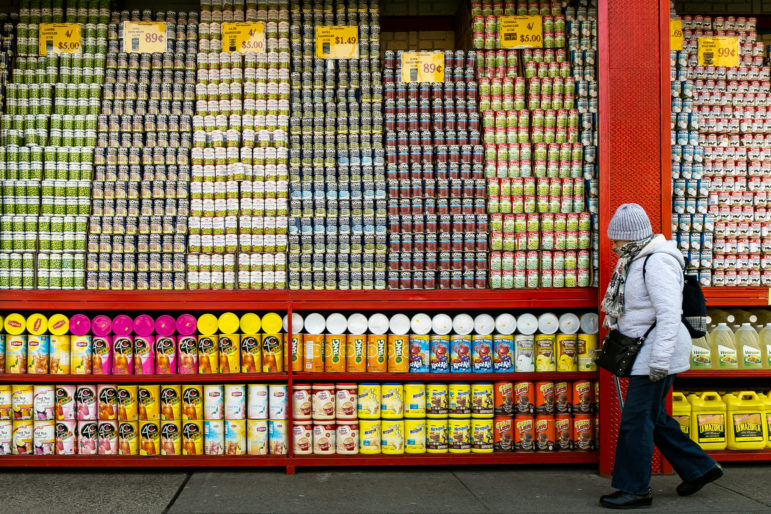
Adi Talwar
A supermarket in Inwood. The city recommends that New Yorkers keep a seven-day supply of food at home in case a disaster interrupts the supply chain.To feed its 8.5 million residents, New York City relies on an interconnected food supply chain clustered around just six major distribution centers—the largest of which are located in flood hazard zones.
These six distribution centers help stock the shelves of supermarkets, bodegas and other suppliers across the five boroughs, ensuring continuous food access for New Yorkers.
But for a city already struggling with high levels of poverty and food insecurity, one extreme weather event has the potential to create widespread disruption across the food supply chain.
With the memory of the damage caused by Superstorm Sandy looming large, city officials, policy experts, hunger activists and community organizers remain concerned about how New York City’s food supply system will fare in the face of future natural disasters.
Food faces the future
As extreme weather events like floods and storms grow more frequent and more severe, the global food supply will become increasingly unstable, according to a report released by the United Nations.
The impact of climate change on food security has already been felt globally due to warming temperatures and rises in extreme weather events, the report found.
These findings come as many New Yorkers are already struggling with food insecurity and the rising price of food.
According to the Food Bank for New York City, the price of groceries has risen nationwide by approximately 16 percent since December 2007. In New York City, this number is even greater, at 17.4 percent.
With 1.75 million New Yorkers living below the federal poverty line in 2016, New York City’s poverty rate is 35 percent higher than the national average. And with high rates of poverty, food insecurity arises.
According to Feeding America, 13.8 percent of New York City residents—more than 1.3 million New Yorkers—were food insecure in 2017. That number was even higher in the outer boroughs, with 17.1 percent of Brooklyn residents and 16 percent of residents in the Bronx facing food insecurity.
“To the degree that New York City is all vulnerable to flooding, low-income people are more vulnerable,” says Joel Berg, CEO of Hunger Free America. “And we don’t have a great system [in place] for when that happens.”
Nearly 1.6 million New Yorkers were receiving Supplemental Nutrition Assistance Program (SNAP) benefits as of June 2019. And recent cuts to SNAP put nearly 700,000 Americans at risk of losing their benefits.
“I don’t know that you’re going to see the cataclysm worldwide for everyone like people are predicting,” Berg says, referencing global predictions of decreased food access. “I think more likely, you’re going to see low-income people suffering.”
While levels of poverty and food insecurity have decreased in recent years, climate change and climate disasters threaten to reverse that pattern.
During natural disasters, “people who have never experienced hunger or want are introduced to both in real time,” said Margarette Purvis, CEO of the Food Bank For New York City, in a 2012 special message on the food bank’s response to Hurricane Sandy.
When storms hit
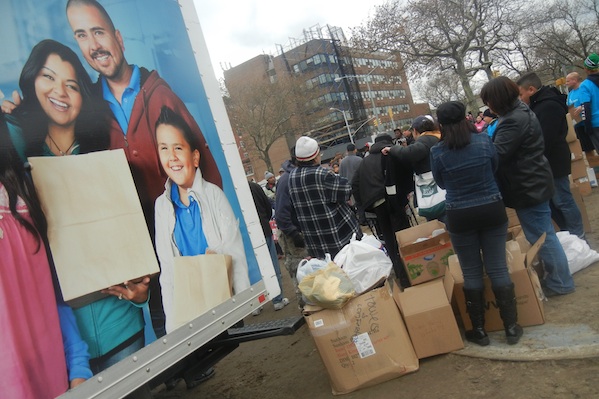
New York City’s food supply systems favor clustering of distribution centers and manufacturers in order to keep shipment costs efficient and increase revenue.
However, this centralized system poses risks. When neighborhoods that are home to these food distribution clusters are impacted by extreme weather, entire parts of the city’s food supply chain are threatened—and so is residents’ ability to access food.
“Having a very centralized food system is very uncomfortable,” says Charles Platkin, Executive Director at the Hunter College New York City Food Policy Center. “And it’s not smart for a city that’s already teetering with high levels of food insecurity and severely underserved communities.”
New York City’s major food distribution clusters include Hunts Point, College Point and Sunset Park. Hunts Point Food Distribution Center is the largest, producing 4.5 billion pounds of food each year, roughly half of which remains in New York City.
Flanked by the East River on two sides and the Bronx River on the third, the Hunts Point distribution center—located in a low-lying peninsula, as well as in the 100-year floodplain according to FEMA’s Preliminary Work Maps—is increasingly vulnerable to climate change and extreme weather events.
Sunset Park’s location also makes it vulnerable. According to the Regional Plan Association report “Under Water: How Sea Level Rise Threatens the Tri-State,” the industrial areas of Sunset Park, as well as the Brooklyn Navy Yard, could face permanent flooding if sea levels continue to rise.
“When Sandy came, significant portions of Manhattan, and certainly Queens and Brooklyn, were underwater,” says Berg. “And if the sea level was even a few inches higher, it would have been catastrophic.”
During Superstorm Sandy, distribution of New York City’s food supply was impacted across multiple networks, including power, transportation, liquid fuel and telecommunication.
There were delays in truck-based freight and fuel supply shortages. Retailers lost inventory due to direct damage and floodwaters. Power outages prevented stores from processing credit card or Electronic Benefits Transfer (EBT) transactions.
Because the impacts were concentrated within Sandy Inundation Zones, entire neighborhoods found themselves with limited or no retail food access. Flooded roads and subway stations compounded the problem, making it difficult for residents to travel to unaffected areas for food.
Sunset Park, where the city’s third largest food distribution cluster is located, was directly hit by the storm.
“Places nearest the water are often more likely to be low-income neighborhoods, at least the ones that aren’t well protected,” says Berg. “Battery Park is better protected than Far Rockaway.”
The timing of the Superstorm Sandy left many New Yorkers particularly vulnerable, according to Purvis.
“Because the storm descended upon us at the end of the month, New Yorkers caught between a lack of remaining food stamps and impending rent were especially vulnerable,” said Purvis in the special message.
But while Superstorm Sandy affected retail food access in much of Lower Manhattan, Queens, and Brooklyn, its damage narrowly avoided New York’s northernmost borough, averting widespread disruption across the city’s food supply chain.
Had Sandy taken a different path or arrived during high tide, the Hunts Point area, including the food distribution center, could have faced varying degrees of flooding, loss of power and inventory and major operational interruptions.
“Just one natural disaster could devastate the supply of fruits and vegetables, as well as fish and meat in New York City,” Alexina Cather, Deputy Director at the Hunter College New York City Food Policy Center, says.
Halting resilience efforts at Hunts Point
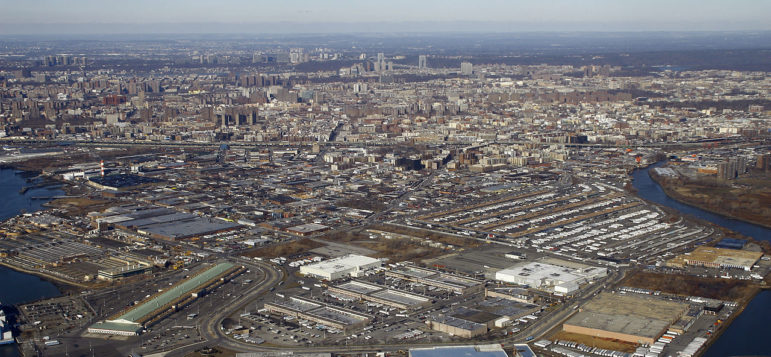
Doc Searls
The sprawling Hunts Point Food Distribution Center handles 4.5 billion pounds of food each year.In 2018, Cather co-authored a report spotlighting Hunts Point Distribution Center with the center’s executive director Charles Platkin and Emily Payne. The report sheds light on vulnerabilities and offers a glimpse into the cooperative markets’ operations.
Inventory at Hunts Point is estimated to always be in excess of one million dollars, roughly four to five days of food for the city.
If Hunts Point Distribution Center was damaged and could no longer function, Manhattan would only have three days’ worth of food, according to Cather and other experts in the field.
“We saw with Sandy; it became very evident that there’s a short supply of food,” Ellen Neises, co-project leader of the Hunts Point Lifelines said in a video on the subject. “If the markets go down, the whole region’s food supply is at risk.”
Recognizing the need to protect Hunts Point against storm surge and flooding in 2013, then-Mayor Michael Bloomberg released a comprehensive plan to increase the resilience of the city’s infrastructure and fortify food distributors. Subject to available funding, an integrated flood protection system was to be installed in Hunts Point.
Building off this plan, Mayor Bill de Blasio announced an investment of $150 million over 12 years to expand capacity, remediate underutilized properties and improve resiliency at Hunts Point.
De Blasio’s announcement came after Rebuild by Design, a federal competition launched by the Hurricane Sandy Rebuilding Task Force, awarded a winning proposal for the Hunts Point peninsula.
Referred to as the Hunts Point Lifelines, the proposal outlined four “Lifelines,” which include a flood protection greenway (referred by the project creators as the first and essential piece), private and public job creation, maritime emergency supply lines and cleanways.
But with a price tag of almost $1 billion, the city decided against implementing the lifelines, citing that cost was not something feasible for the immediate term.
“We’ve been in close coordination with the Hunts Point Resiliency Advisory and the Mayor’s Office of Resiliency to research and design a Hunts Point Resiliency project that will protect residents and businesses from the impacts of climate change,” New York City Economic Development Corporation (NYCEDC) spokesperson Shavone Williams said in a statement provided to City Limits.
Seven years after Superstorm Sandy, the NYCEDC has decided to move forward on a singular pilot project, with $20 million awarded through HUD federal funding and another $25 million allocated from the city.
The Hunts Point Resiliency pilot project includes a tri-generation microgrid, which will create back-up power for Hunts Point and allow two schools in the area, PS 48 and MS 424, to serve as storage and power sources during emergency situations.
In addition to the tri-generation microgrid, the project includes mobile diesel generators, which will be deployed to critical facilities during emergency situations.
“Through careful analysis and extensive engagement with the community, we’ve identified sustainable solutions that will provide power and flood protection for residents and businesses in Hunts Point,” the statement continues.
An exact timeline for implementation has yet to be finalized. NYCEDC hopes to complete construction by 2022.
While this effort will ensure back-up power to Hunts Point and allow the schools to serve as emergency and cooling shelters for the neighborhood after completion, critics say this is only one piece of the protective puzzle and leaves the distribution center vulnerable in the interim.
As it currently stands, if Hunts Point Food Distribution Center were to lose power, it is up to the individual tenants to invest in generators or flood insurance. Because insurance protection comes at a much lower cost, many are unlikely to consider the pricier safeguards like generators.
As City Limits reported in 2017, “NYCEDC says it is the responsibility of individual businesses and the three cooperative markets to implement their own individual preparedness strategies.”
But without incentivized programs or a city-sponsored push for more permanent protections, individual businesses who rent space at Hunts Point Food Distribution Center may not prioritize hardening efforts.
“[Hunts Point Distribution Center] is a city-owned property, coordinated by the city, with oversight by the city,” Platkin says. “New York City has a responsibility to come up with a way to feed New Yorkers if there’s a crisis.”
Other weaknesses
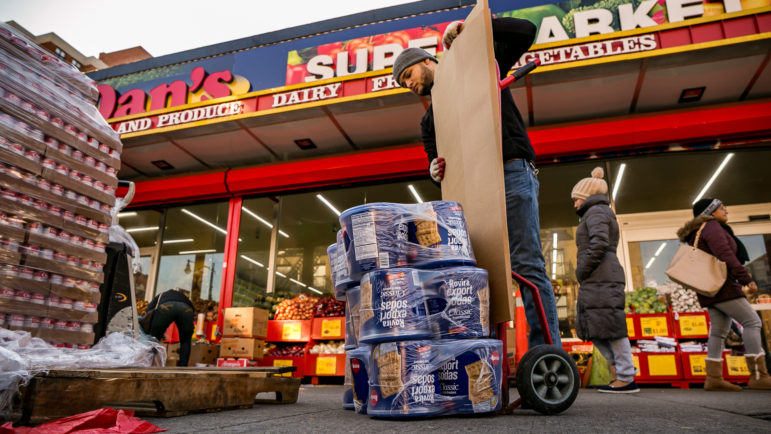
But protecting Hunts Point only protects a midpoint in a complex food supply system.
Because of limited storage space, food outlets across all five boroughs use a continuous food delivery system, otherwise known as just-in-time inventory.
Chain supermarkets typically stock six to seven days worth of food, compared to four to five days stocked at chain convenience stores and three to five at bodegas and schools.
However, when extreme weather events are anticipated, certain suppliers send more deliveries to restock food to meet increased customer demand. Ninety-nine percent of this last-mile food distribution travels via truck.
When vehicle access is restricted due to flooding, delays at major bridge crossings and road closures, the ability of suppliers to restock is jeopardized.
According to NYC Food by the Numbers, 95 percent of food that travels into New York City is carried by truck. It’s estimated that nearly 30 percent of trucks crossing the George Washington Bridge each day are carrying food.
Forty-six percent of food distributed in New York City is refrigerated or frozen, reliant on a functioning power grid. Based on this dependence on electricity, almost half of the city’s food could become inedible during a power outage of greater than four hours.
Supermarkets and bodegas’ stock of nonperishable foods stored on lower shelves or in cellar storage spaces may also be damaged due to flooding, as well as communications services and gasoline supplies.
“The food banks and food rescue groups, as well as the pantries and kitchens, need more resources to be able to build their resiliency,” Berg says. “We need to plan New York City better how to get SNAP and WIC in a crisis.”
On the fifth anniversary of Hurricane Sandy, Food Bank for New York City team members participated in a surprise disaster response drill at its 90,000 square foot warehouse in Hunts Point. In the fictional scenario, coined Hurricane Darnell, electricity, transportation, bridges, gasoline and communications services were out through the entirety of the city.
“Superstorm Sandy showed us that disasters make emergency food clients out of everyday New Yorkers,” said Purvis in a press release on the drill. “It is our duty to the people of this city to always be prepared.”
According to New York City Emergency Management (NYCEM), the city maintains an Emergency Supply Stockpile that contains thousands of pallets of cots, blankets, food, water, baby and pet supplies, and medical supplies. After Sandy, the stockpile was augmented “with items including clothing, diapers, baby cribs, supplies for people with disabilities, and a cache of Kosher and halal meals,” the agency says.
Emergency back-up supplies
According to the New York State Elected Officials Guide to Emergency Management, “it is the responsibility of every citizen in the State to ensure that they and their families have taken the necessary steps needed to prepare for a major disaster.”
These steps include making an emergency plan, preparing an emergency kit, becoming informed of potential disasters and hazards and getting involved with disaster volunteer organizations.
The New York State Division of Homeland Security & Emergency Services created an emergency awareness website, which seeks to provide citizens, businesses and communities with information on emergency and disaster preparedness.
NYCEM recommends stockpiling enough supplies to survive for at least a week, including a gallon of drinking water per person per day and nonperishable, ready-to-eat canned foods, among other supplies for health conditions, child care and first aid.
“If possible, keep materials in an easily accessible, separate container or special cupboard. Individuals should indicate to their household members that these supplies are for emergencies only,” NYCEM recommends.
A 2019 NYCEM survey found 57 percent of New Yorkers said they keep a seven-day supply of water and non-perishable food at home in case of emergency. “Of those surveyed 68 percent percent said they felt prepared for an emergency, which could cause them to shelter in place such as a winter storm, and 62 percent said they felt prepared for the various emergencies, which can happen in New York City,” NYCEM says.
A 2015 study conducted by researchers at New Mexico State University and Rutgers looked at the adequacy of household emergency food supplies of 100 food secure families in New Jersey.
On average, the households had 33 days of food for all household members to meet 100 percent of their daily caloric needs. Loss of water, power, or both would decrease total household members’ ability to meet caloric needs.
While this study concluded that food secure families were adequately prepared and have low vulnerability to emergency-induced food insecurity, this sample size is not reflective of low-income families who face higher rates of food insecurity even in non-emergency situations.
Grassroots organization and community-based efforts are also helping New Yorkers prepare for future extreme weather events through climate health education and support networks.
For example, the Be A Buddy program, led by Hunts Point community development center THE POINT, in partnership with NYC Department of Health and Mental Hygiene and the Mayor’s Office of Resiliency, creates a network of local volunteers who support other residents who have identified themselves as vulnerable to climate and extreme weather. Many of these residents are of the city’s aging population, have chronic medical conditions or live alone, among other criteria.
“The program seeks to connect these residents with local resources and services that could best aid them and to create greater awareness around how climate affects public health and how to be better prepared as a community,” says Fernando Ortiz, Climate Preparedness and Resiliency Organizer at THE POINT.
Through coalitions with other grassroots organizations like the New York City Environmental Justice Alliance, THE POINT works to build community resilience and social cohesion, as well as advocating for policy change and increased funding.
“The main challenge we face is equity,” Ortiz says. “Communities of low-income, of color and large immigrant populations have historically been underserved by the city, so we still face challenges around more funding going towards more affluent communities and disinvestment in our communities.”
Berg says Hunger Free America wants to make sure that the food sector is better protected across the board and New York City has improved resilience, regardless of neighborhood or socioeconomic status.
“There’s no question that the whole city, including its food supply, is at very significant risk.”
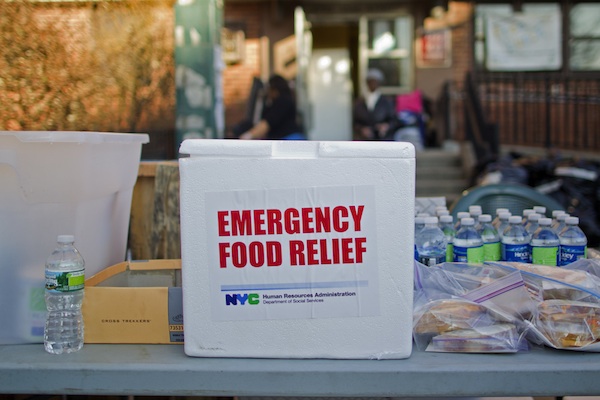









5 thoughts on “What Climate Risks Mean for NYC’s Food Supply”
safiul
After one year, the situation remains the same. Nothing has changed. The only thing that has changed is some increase in the price of goods and the worsening of people’s lives because of the pandemic.
Climate change is very important for all because it impact very high to human lives.
Thank you so much for this article. it has been a good resource when writing my Master’s thesis. I just felt it worth to acknowledge your good work by leaving this comment.
It is what I want to say